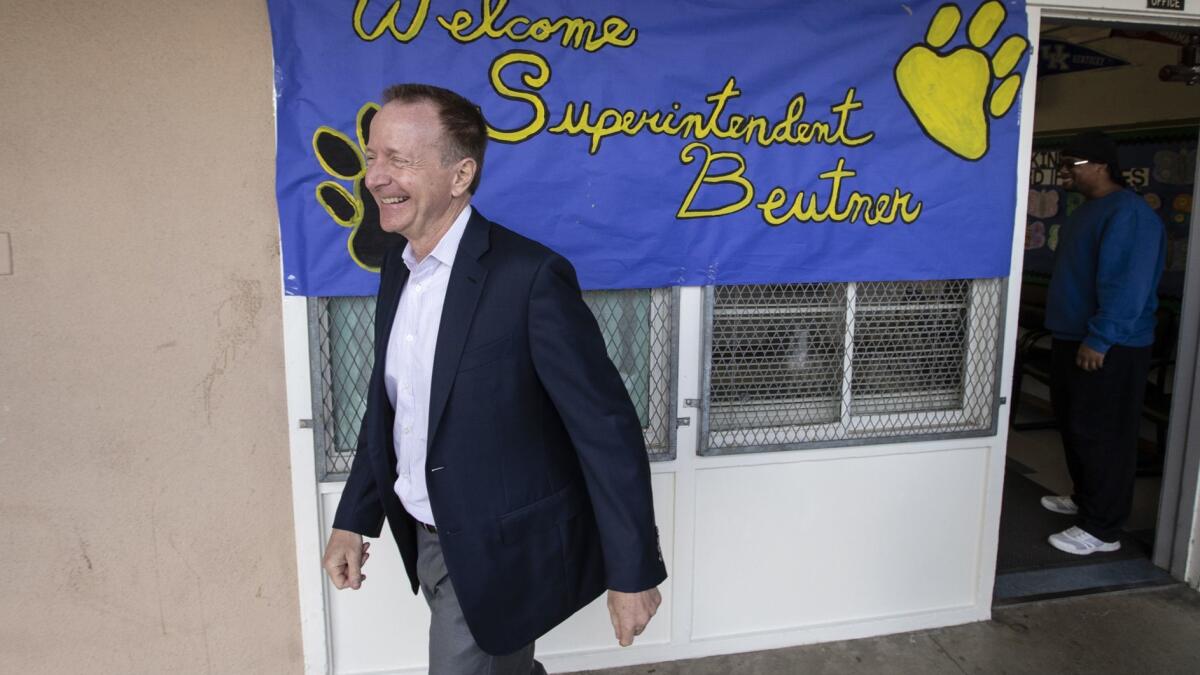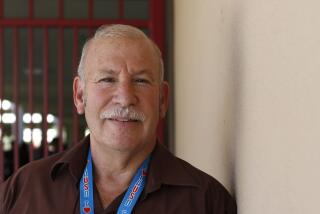School chief’s plan would divide L.A. school district into 32 networks

Los Angeles schools chief Austin Beutner is working on a plan to radically reshape the nation’s second-largest school district by shrinking the central bureaucracy and moving decision-making closer to campuses.
The aim is to boost student success and save money at a time when officials insist that grave financial problems threaten the Los Angeles Unified School District’s solvency.
Under a proposal being developed confidentially, Beutner would divide the system into 32 “networks,” moving authority and resources out of the central office and into neighborhoods. He is expected to make his plan public next month.
In L.A. Unified’s downtown headquarters, managers and other employees recently have been asked to explain their duties — and to justify why their jobs should continue to exist in a leaner, more localized school system.
The network strategy is not a plan to break up or end L.A. Unified, but it could transform how the school system functions.
“The superintendent is trying to move toward a decentralized system that puts the student first,” said one person close to the process who was not authorized to comment publicly. “He’s trying to generate better educational outcomes. That’s the No. 1 goal.
“Savings from the central bureaucracy could be plowed back into education at the school level,” he said, “as well as [used] to deal with the fiscal crisis the district faces.”
Beutner declined to comment on the plan, saying it would be premature to talk about a work in progress.
The Times learned details of Beutner’s developing strategy through documents and interviews. Its broad outlines were confirmed by numerous people involved in the planning who requested anonymity.
This is not the first time a superintendent has proposed reorganizing L.A. Unified.
Some past attempts have been short-lived or fell far short of expectations. Moves meant to save money sometimes turned out to be costly.
In 1993, the district announced it would divide the system into 32 self-governing “clusters.” That plan ultimately morphed into another — and another and another.
“If the underlying services are not different or better, then the structure doesn’t matter much,” said another insider, who asked to remain anonymous. “If you end up reorganizing for the sake of reorganizing, you can cause a lot of chaos.”
Although the internal planning has been confidential, officials say they have collected input from about 1,500 parents, teachers, administrators and community members in a series of meetings since August.
How the networks would be shaped and what duties they would have still is being refined, with the assistance of consultants paid for by outside philanthropy. One of the consulting firms, Kitamba, has senior executives who have been involved in high-profile reform efforts elsewhere in the country. London-based business consulting firm Ernst & Young is working on the goal of improving efficiency.
A major restructuring would require approval by the Board of Education. Beutner has been working more closely with some board members than others — apparently to try to minimize leaks.
Although change in the district rarely comes easy, Beutner has the added challenge of making his push at a time when an ongoing contract dispute with the teachers union could lead to a strike.
One district argument is at the center of both the contract negotiations and the “reimagining” plan, as it is often referred to internally. Beutner repeatedly has pointed to analyses that conclude L.A. Unified is now spending $500 million a year more than it takes in. Without change, according to projections, reserves will run dry in three to four years. The teachers union has rejected those forecasts.
Beutner’s push to be superintendent was championed by philanthropists and civic leaders who largely view L.A. Unified as a failed institution, with its looming fiscal problems and student test scores that trail state averages. They see in Beutner — a wealthy businessman without a background in education — a leader with the financial savvy and outsider’s perspective necessary to shake up an entrenched and complacent system.
Some specifics of Beutner’s plan probably will change, but the following outline appears to have emerged:
- The networks of schools would be based mainly on geography.
- Each network would include elementary, middle and high schools — with cohesive academic programs for students as they progress through the system.
- Each network would report to one of several regional headquarters.
- Staffing at the central district office downtown would be sharply reduced, as would its spheres of authority.
- Schools and their networks would get more control in key areas such as hiring and budgets.
Major elements remain under discussion. One topic of debate has been how much to let traditional district-run schools begin to operate like independent charter schools.
Charters are exempt from some regulations that govern district-run schools and most are non-union. The school district plays no role in a charter’s day-to-day management, though it does decide every five years whether to renew a charter’s right to operate.
According to some insiders, Beutner’s plan seems like rearranging the deck chairs because six regional district offices already exist and deal extensively with local schools. Academic coordinators in those offices oversee students’ grade-by-grade progress in key subjects such as math and English.
District staff members, however, are nervous.
“Nobody knows what the future is going to look like for the district or for their jobs,” said one central office staff person who asked to remain anonymous. “Ernst & Young is evaluating positions in every division along the lines of whether they are discretionary.”
One email obtained by The Times that has been circulating in the fiscal division set out the task to those being asked to justify their roles: “Please work with your teams to identify four to six primary functions that your Division performs.”
“The superintendent’s office is the audience for this project,” the email said, “so make sure that the functions are easy for someone outside of your office to understand.”
Kitamba partner and chief executive Rajeev Bajaj, while heading different companies, became a major consultant in 2010 and 2011 for the school-reform effort in Newark, N.J. The companies in which he was involved attracted media attention because of potential conflicts involving business ties to state and local officials.
His partner at Kitamba, Erin McGoldrick Brewster, served as chief of data and accountability for the District of Columbia Public Schools, under hard-charging former Supt. Michelle Rhee. In 2009, McGoldrick Brewster, along with Rhee, came under scrutiny for not pushing harder to investigate credible allegations of cheating at schools that showed huge gains on standardized tests.
The work of Ernst & Young and Kitamba is being paid for by the recently established Fund for Equity and Excellence, which pools philanthropic resources for local education. Donors include the Ballmer Group, the California Community Foundation, the California Endowment, the Eli and Edythe Broad Foundation and the Weingart Foundation.
In 2007, New York City experimented with substantially replacing its centralized bureaucracy with several dozen networks, some run by the city’s Department of Education and some operated by nonprofit groups.
The networks got mixed reviews, in large part because they weren’t geographically based. They were also criticized for muddying the lines of authority. The decentralization cut costs, but it had little effect on students’ academic performance.
After about eight years, the networks were largely dismantled. The nation’s largest school district returned to a system that empowered regional superintendents.
Twitter: @howardblume
Twitter: @annamphillips
UPDATES:
3:25 p.m.: This article was updated throughout to edit and streamline the information.
This article was originally published at 9:30 a.m.
More to Read
Start your day right
Sign up for Essential California for news, features and recommendations from the L.A. Times and beyond in your inbox six days a week.
You may occasionally receive promotional content from the Los Angeles Times.








